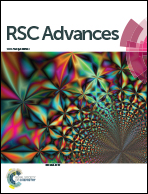Partial intercalative binding of the food colorant erythrosine to herring sperm DNA
Abstract
Erythrosine (Ery) is an artificial colorant extensively used in the food industry, but may have a potential safety risk. In this study, the characteristics of the interaction in vitro between Ery and herring sperm DNA (hsDNA) were determined by multi-spectroscopic techniques and docking simulations. The multivariate curve resolution-alternating least squares chemometrics approach was used to process the expanded UV-vis spectral data matrix, and both the equilibrium concentration profiles and the pure spectra for the components (Ery, hsDNA and Ery–hsDNA complex) extracted from the highly overlapping composite response were obtained simultaneously to monitor the Ery–hsDNA interaction process. Partial intercalation as the dominant mode of Ery binding to hsDNA was found based on the hypochromism and red shift effect of Ery, stronger double DNA effect and decrease in hsDNA viscosity. The Fourier transform infrared and nuclear magnetic resonance spectra showed that the benzene ring of Ery most likely inserted into the guanine and cytosine bases of hsDNA, and molecular docking predicted and visualized the specific binding. The circular dichroism and DNA cleavage assays suggested that Ery at high concentrations may perturb B-DNA conformation and cause slight DNA cleavage. This study has provided insights into the binding mechanism of Ery with hsDNA and potential hazards of the colorant.


 Please wait while we load your content...
Please wait while we load your content...